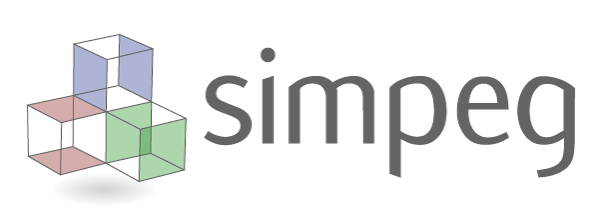Simulation and Parameter Estimation in Geophysics - A python package for simulation and gradient based parameter estimation in the context of geophysical applications.
The vision is to create a package for finite volume simulation with applications to geophysical imaging and subsurface flow. To enable the understanding of the many different components, this package has the following features:
- modular with respect to the spacial discretization, optimization routine, and geophysical problem
- built with the inverse problem in mind
- provides a framework for geophysical and hydrogeologic problems
- supports 1D, 2D and 3D problems
- designed for large-scale inversions
You are welcome to join our forum and engage with people who use and develop SimPEG at: https://simpeg.discourse.group/.
Weekly meetings are open to all. They are generally held on Wednesdays at 10:30am PDT. Please see the calendar (GCAL, ICAL) for information on the next meeting.
Working towards all the Geophysics, but Backwards - SciPy 2016
There is a paper about SimPEG!
Cockett, R., Kang, S., Heagy, L. J., Pidlisecky, A., & Oldenburg, D. W. (2015). SimPEG: An open source framework for simulation and gradient based parameter estimation in geophysical applications. Computers & Geosciences.
BibTex:
@article{cockett2015simpeg,
title={SimPEG: An open source framework for simulation and gradient based parameter estimation in geophysical applications},
author={Cockett, Rowan and Kang, Seogi and Heagy, Lindsey J and Pidlisecky, Adam and Oldenburg, Douglas W},
journal={Computers \& Geosciences},
year={2015},
publisher={Elsevier}
}If you are using the electromagnetics module of SimPEG, please cite:
Lindsey J. Heagy, Rowan Cockett, Seogi Kang, Gudni K. Rosenkjaer, Douglas W. Oldenburg, A framework for simulation and inversion in electromagnetics, Computers & Geosciences, Volume 107, 2017, Pages 1-19, ISSN 0098-3004, http://dx.doi.org/10.1016/j.cageo.2017.06.018.
BibTex:
@article{heagy2017,
title= "A framework for simulation and inversion in electromagnetics",
author= "Lindsey J. Heagy and Rowan Cockett and Seogi Kang and Gudni K. Rosenkjaer and Douglas W. Oldenburg",
journal= "Computers & Geosciences",
volume = "107",
pages = "1 - 19",
year = "2017",
note = "",
issn = "0098-3004",
doi = "http://dx.doi.org/10.1016/j.cageo.2017.06.018"
}If you have a question regarding a specific use of SimPEG, the fastest way to get a response is by posting on our Discourse discussion forum: https://simpeg.discourse.group/. Alternatively, if you prefer real-time chat, you can join our Mattermost Team at https://mattermost.softwareunderground.org/simpeg. Please do not create an issue to ask a question.
SimPEG hosts weekly meetings for users to interact with each other, for developers to discuss upcoming changes to the code base, and for discussing topics related to geophysics in general. Currently our meetings are held every Wednesday, alternating between a mornings (10:30 am pacific time) and afternoons (3:00 pm pacific time) on even numbered Wednesdays. Find more info on our Mattermost.
Website: https://simpeg.xyz
Forums: https://simpeg.discourse.group/
Mattermost (real time chat): https://mattermost.softwareunderground.org/simpeg
Documentation: https://docs.simpeg.xyz
Code: https://github.com/simpeg/simpeg
Tests: https://dev.azure.com/simpeg/simpeg/_build
Bugs & Issues: https://github.com/simpeg/simpeg/issues
We always welcome contributions towards SimPEG whether they are adding new code, suggesting improvements to existing codes, identifying bugs, providing examples, or anything that will improve SimPEG. Please checkout the contributing guide for more information on how to contribute.








